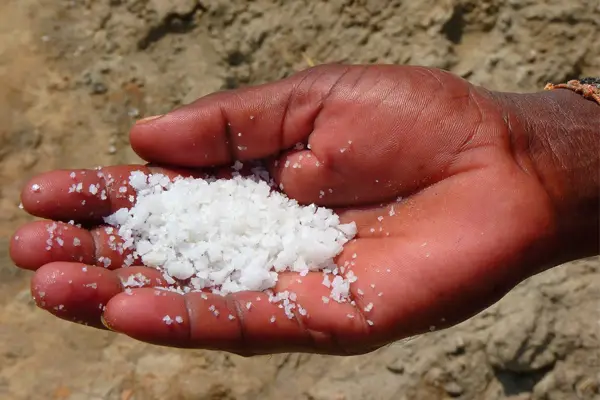
Our planet is drowning in plastic. It has contaminated our land and water, and now is being found in salt, in particularly the healthy, mineral-rich sea salt.
A new study has tested 16 brands of sea salt from eight different countries, and 15 of them contained traced of microplastics (MPs).
Microplastics are plastic particles sized just between 1 and 1000 micrometer. They are tiny, but there are so many of them out there that many scientists are considering microplastic pollution the biggest environmental problem with not enough attention being drawn to it.
These toxic MPs often come from the textile industry; synthetic clothes end up in water supplies during laundry. Other industries to blame for this type of pollution are the abrasive blasting industry and the cosmetics industry, among others.
The plastics from these industries have ended up in the Celtic sea (a popular sea salt source), Laurentian Great Lakes, Persian Gulf, and in sub-tropical gyres. All these water bodies are full of MPs, and therefore, the products that come from these sources are as well: clams, fish, and sea salt.
Studies claim that calculating human health risk due to MPs is not yet possible. The issue raises, however, a huge concern because MPs have been tested to contain toxic chemicals and microorganisms.
Human Annual Intake of Microplastics and Their Effect on Health
How many MPs do we unknowingly consume? One study has calculated that a European consumer intakes up to 11,000 MPs every year. Much of these MPs come from mussels and oysters.
Though many people, especially living far from water, do not consume that many fish products, sea salt is another issue. Salt in general is the number one food seasoning, and sea sat became popular due to its healthy mineral content.
The study that tested sea salt calculated that if a person consumes the daily recommended amount of salt, they would intake about 37 MPs per year from salt alone, but MPs also end up in our system from clams, mussels, fish, and even honey, and beer. It’s the overall consumption of all MPs from all different sources that raises a concern.
Which Sea Salt Contains The Most Plastic?
According to the study that tested different brands of salt, the most contaminated salt, to sadly no one’s surprise, came from China. Chinese salt from different brands contained an average of 681 MPs per kilogram.
Other countries have a much smaller contamination rating.

Microscopic images of some of the extracted particles found is sea salt. PHOTO: Nature.com
The 16 brands the study has personally tested contained 72 completely different MP-like particles, out of which 30 were identified as plastic polymers, 17 as pigments that could be former plastics, 4 were non-plastic items, and 21 could not be identified (it was not disclosed which brands were tested, but all were purchased in Malaysia).
The one pigment found of the most concern was lead chromate (yellow), which has been linked to cancer, cerebrovascular disease, and nephritis (inflammation of the kidneys) in humans. However, it has been found only in trace amounts.
The 30 plastic polymers found were made up of:
polypropenes (coming from packaging and textiles)
polyethenes (plastic bags)
polyethylene terephthalate (plastic bottles and synthetic fibers)
polyisoprene (rubber and resins)
polyacrylonitrile (fibers used in bicycles, fishing rods, and other common items)
polyamide-6 (nylons)
These chemicals are known to cause liver toxicity and cancers at high doses. The study did say that “the low level of anthropogenic particles intake from the salts (maximum 37 particles per individual per annum) warrants negligible health impacts,” but added that further research needs to be done to understand the health risks of salt consumption.
The Best and Worst Brands of Sea Salt for Plastic Contamination
The most contaminated salt was from Portugal with 10 MPs per kilogram. Only one sample was found to have no MPs, and it came from France.
Here is how the salt from all the countries rated from most to least contaminated:
16 MPs total. Portugal: up to 6 plastic polymer MPs and up to 10 pigment particle MPs
11. Australia: up to 2 plastic polymer MPs and 9 pigment particle MPs
4. France: up to 2 and 2 MPs of both kinds
4. South Africa: 3 plastic polymer MPs and 1 pigment particle MP
1. Iran: 1 pigment particle MP
1. Japan: 1 plastic polymer MP
1. Malaysia: up to 1 MP each
1. New Zealand: 1 pigment particle MP
These findings show that a person intakes an average of 37 MPs from salt annually, not taking into account the other sources of fish, sea products, honey, and beer. Even though the numbers are small, it’s the overall consumption of all MPs from all different sources over a lifetime that raises a concern.
The study authors say we need to treat these plastics as unhealthy, until we can prove otherwise. But how can they be safe? Most of these contaminants have been linked to health issues before.
What is also worrisome is that the plastic contamination of the waters is becoming worse every year, as an estimated 10 billion pounds of plastics may their way into the ocean every year. Research predicts that by 2050 there will be more plastic in the water than fish!
It can be therefore predicted that there may be more and more MPs found annually. Unfortunately, there is not much one can do as a consumer to avoid MPs – other than avoid salt (and basically everything else) that comes from China, and limit their intake of sea products; as well as detox from plastics on a regular basis.
Recommended reading:
This Is The Biggest Environmental Problem You’ve Never Heard Of. And It’s A HUGE Part Of Your Life
Chinese Companies Are Mass Producing Plastic Rice (and It Could Cause Serious Health Problems)
Top 10 Toxic Fake Food Items Produced In China
Thanks for installing the Bottom of every post plugin by Corey Salzano. Contact me if you need custom WordPress plugins or website design.





